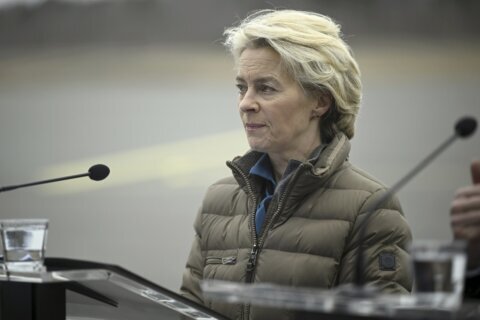The American boat in The Ocean Race received permission on Friday to replace its cracked foils before the next leg of the around-the-world race — a 12,750-nautical mile run to Brazil that is the longest in the 50-year history of the event.
“We are pleased with the Race Committee’s decision to allow us to replace the damaged foils, which will allow us to compete in the next Leg in a safe and seamanlike manner,” 11th Hour Racing Team CEO Mark Towill said. “We will continue to work with our design and engineering teams on a repair plan, and look forward to getting Mālama back in the water, and back to racing next week.”
Foils are curved appendages protruding from the hull that lift the boat above the waves in certain conditions to reduce drag and make it sail faster. They have been incorporated into the America’s Cup and other major sailing races, including some Olympic classes, but are being used for the first time in The Ocean Race.
The Newport, Rhode Island-based team discovered the damage when the boat was lifted from the water after arriving in Cape Town for the completion of the second leg. The team said in a statement that the foils need to be sent to the manufacturer in Europe for repairs that could not be completed before the boats leave for Itajaí on Feb. 26.
To replace the foils, 11th Hour Racing needed permission from race organizers, which was granted on Friday. The backups will be installed over the weekend and allow the boat to return to the water on Tuesday.
“To head into the Southern Ocean for nearly a month with two damaged foils would be foolhardy and not a risk that I am prepared to take,” 11th Hour Racing Team skipper Charlie Enright said from Cape Town, South Africa, where the boats had a two-week layover before the start of the third leg. “Not for the safety of my crew, of the boat, nor for our competitors, who ultimately are our safety net down there.”
The team said sensors first indicated a spike in the loads on the foils near the end of the first leg, from Allicante, Spain, to Cabo Verde. An inspection revealed multiple cracks on the port foil; the starboard foils revealed similar damage after arrival in Cabo Verde.
With only five days during the stopover, the crew decided to continue to Cape Town, where a longer stopover would allow for more complete testing.
Enright, who co-founded 11th Hour Racing Team with Towill, a fellow Brown alum, is in his third around-the-world race. Towill stepped away from the crew and became team CEO to oversee construction of the boat for this race.
The team finished fifth in both previous races — including in the last edition, after two major setbacks.
Its sloop collided with a Chinese fishing boat in the dark while approaching Hong Kong at the end of Leg 4 in 2018, killing one person aboard the fishing boat, which sank. The race boat also was damaged and had to be shipped to New Zealand.
The sloop also dismasted off the Falkland Islands while the team was in second place on Leg 7. The crew motored to the Falkland Islands, where a jury rig was fashioned before a delivery crew motored the 1,200 nautical miles to the next port.
___
AP Sports Writer Bernie Wilson contributed to this report.
___
AP sports: https://apnews.com/hub/sports and https://twitter.com/AP_Sports
Copyright © 2024 The Associated Press. All rights reserved. This material may not be published, broadcast, written or redistributed.






